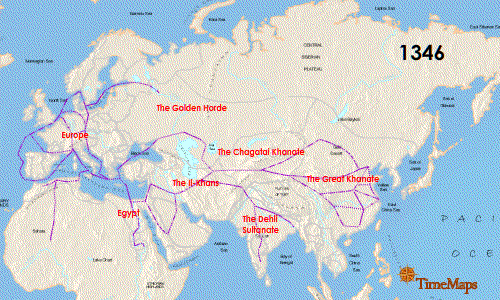Ecological competence is the ability of an organism, often a pathogen, to survive and compete in new habitats. If a pathogen does not have this, it will likely become extinct. In the case of plant pathogens, it is also their ability to survive between growing seasons. For example, peanut clump virus can survive in the spores of its fungal vector until a new growing season begins and it can proceed to infect its primary host again.
Epidemiology is another important tool used to study disease in a population. For infectious diseases, it helps to determine if a disease outbreak is sporadic (occasional occurrence), endemic (regular cases often occurring in a region), epidemic (an unusually high number of cases in a region), or pandemic (a global epidemic). The Black Death (plague) of the 14th century reduced the world population from an estimated 450 million to 350 - 375 million .

The Black Death of the 14th century
An animation of the plague that spread through the world during the pandemic in the 14th century.
In most cases, microorganisms live in harmony with their hosts via mutual or commensal interactions. Diseases can emerge when existing parasites become pathogenic or when new pathogenic parasites enter a new host. Coevolution between parasite and host can lead to hosts becoming resistant to the parasites or the parasites may evolve greater virulence, leading to immunopathological disease.
In addition, human activity is involved with many emerging infectious diseases, such as environmental change enabling a parasite to occupy new niches. When that happens, a pathogen that had been confined to a remote habitat has a wider distribution and possibly, a new host organism. Diseases transferred from nonhuman to human hosts are known as zoonoses.
Under disease invasion, when a parasite invades a new host species, it may become pathogenic in the new host. Several human activities have led to the emergence and spread of new diseases, such as encroachment on wildlife habitats, changes in agriculture, the destruction of rain forests, uncontrolled urbanization, modern transport.
According to evolutionary medicine, virulence increases with horizontal transmission (between non-relatives) and decreases with vertical transmission (from parent to child). Optimal virulence is a concept relating to the ecology of hosts and parasites. One definition of this is the host's parasite-induced loss of fitness. The parasite's fitness is determined by its success in transmitting its offspring to other hosts.
At one stage, the consensus was that over time, virulence moderated and parasitic relationships evolved toward symbiosis. This view has been challenged. A pathogen that is too restrained will lose out in competition to a more aggressive strain that diverts more host resources to its own reproduction. However, the host, being the parasite's resource and habitat in a way, suffers from this higher virulence. This might induce faster host death, and act against the parasite's fitness by reducing probability to encounter another host (killing the host too fast to allow for transmission).
Thus, there is a natural force providing pressure on the parasite to "self-limit" its virulence. The idea is then, that there exists an equilibrium point of virulence, where parasite's fitness is highest. Any movement on the virulence axis, towards higher or lower virulence, will result in lower fitness for the parasite, and this will be selected against.